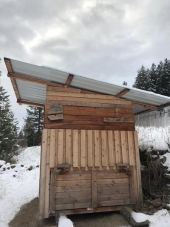
 6
6




 1
1




“All good things are wild, and free.” Henry David Thoreau
 5
5




Sometimes the answer is nothing

 4
4




Idle dreamer
 2
2




wayne fajkus wrote:Henry, i am in a similar situation and feel i made a very creative solution for the problem. My fence will be an arbor. Think of an old clothesline pole. The fencing will be 4ft tall and at a little over 6ft, there will be a 4 to 5ft wide "tee". Wire will be strung along the tees. Grapes, kiwi, or nothing will be grown on the arbors. It should be beautiful when the plants mature.
I have started on it. Most of the fence is done. I just need to install the tee portion of it.
 3
3




Sometimes the answer is nothing


 3
3




List of Bryant RedHawk's Epic Soil Series Threads We love visitors, that's why we live in a secluded cabin deep in the woods. "Buzzard's Roost (Asnikiye Heca) Farm." Promoting permaculture to save our planet.
 3
3




Cultivate abundance for people, plants and wildlife - Growing with Nature



 2
2




Lorinne Anderson: Specializing in sick, injured, orphaned and problem wildlife for over 20 years.
 3
3




Idle dreamer
 2
2




Lorinne Anderson wrote:Deer fencing does not, theoretically, need to be strong - it simply needs to be "visibly obstructing". By this I mean (unless on an existing roadway/escape route) simple fishing line, bird netting, twig, bamboo, lath....are all sufficient, if tall enough (remember to take into account slope - must be higher if deer is coming from uphill!) will work.
![Filename: LadderMesh.jpg
Description: Concrete reinforcing ladder mesh piece [Thumbnail for LadderMesh.jpg]](/t/132316/a/98104/LadderMesh.jpg)




wayne fajkus wrote:Henry, i am in a similar situation and feel i made a very creative solution for the problem. My fence will be an arbor. Think of an old clothesline pole. The fencing will be 4ft tall and at a little over 6ft, there will be a 4 to 5ft wide "tee". Wire will be strung along the tees. Grapes, kiwi, or nothing will be grown on the arbors. It should be beautiful when the plants mature.
I have started on it. Most of the fence is done. I just need to install the tee portion of it.
 2
2




"Skidding rocks is better than rolling them. Rolling is better than lifting. Lifting sucks." -a High School trail crew volunteer
"Don't cut your foot with the axe. It will not add to the pleasures of camp life." -Vacation Camps for Girls circa 1913
 1
1




"Skidding rocks is better than rolling them. Rolling is better than lifting. Lifting sucks." -a High School trail crew volunteer
"Don't cut your foot with the axe. It will not add to the pleasures of camp life." -Vacation Camps for Girls circa 1913
 2
2








Standing on the shoulders of giants. Giants with dirt under their nails
 2
2








Lorinne Anderson: Specializing in sick, injured, orphaned and problem wildlife for over 20 years.




Lila Stevens wrote:
That design sounds like a great idea! I was wondering what plants I could grow on a fence and not have the deer just devour from the outside. Will they not eat grapes and kiwi? Any other vines they don't like?
We'll probably be moving to your general area later this year, so all of your posts are especially helpful to me.
Sometimes the answer is nothing





 3
3




 7
7




Esther Platt wrote:Carla and others, I like your double-fence designs. It looks like most of these double fences have the secondary (short) fence on the outside and tall main one on the inside.


Invasive plants are Earth's way of insisting we notice her medicines. Stephen Herrod Buhner
Everyone learns what works by learning what doesn't work. Stephen Herrod Buhner

|
A day job? In an office? My worst nightmare! Comfort me tiny ad!
turnkey permaculture paradise for zero monies
https://permies.com/t/267198/turnkey-permaculture-paradise-monies
|







